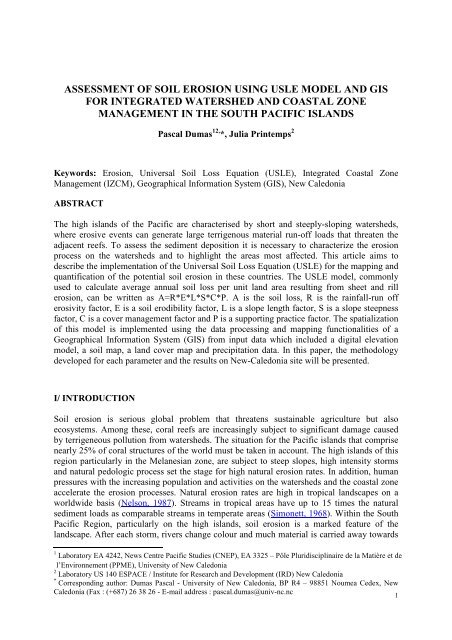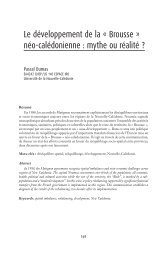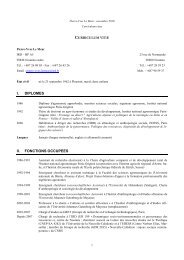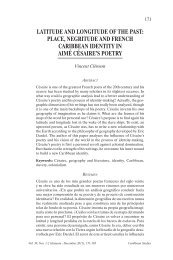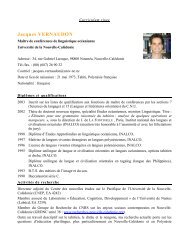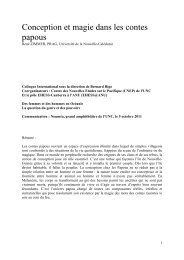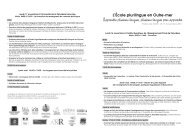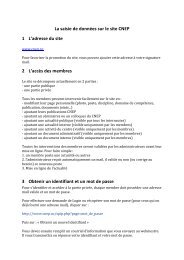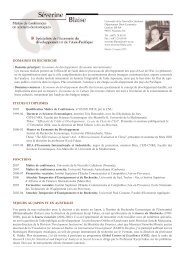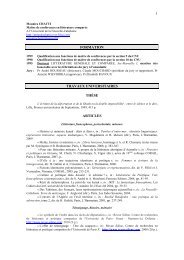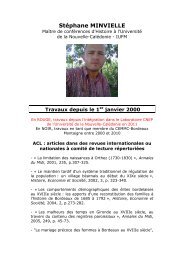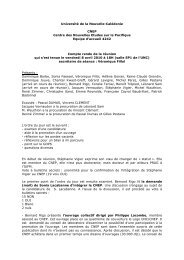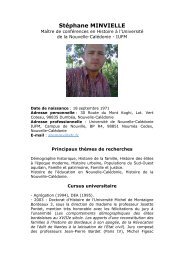assessment of soil erosion using usle model and gis for integrated ...
assessment of soil erosion using usle model and gis for integrated ...
assessment of soil erosion using usle model and gis for integrated ...
You also want an ePaper? Increase the reach of your titles
YUMPU automatically turns print PDFs into web optimized ePapers that Google loves.
ASSESSMENT OF SOIL EROSION USING USLE MODEL AND GISFOR INTEGRATED WATERSHED AND COASTAL ZONEMANAGEMENT IN THE SOUTH PACIFIC ISLANDSPascal Dumas 12, *, Julia Printemps 2Keywords: Erosion, Universal Soil Loss Equation (USLE), Integrated Coastal ZoneManagement (IZCM), Geographical In<strong>for</strong>mation System (GIS), New CaledoniaABSTRACTThe high isl<strong>and</strong>s <strong>of</strong> the Pacific are characterised by short <strong>and</strong> steeply-sloping watersheds,where erosive events can generate large terrigenous material run-<strong>of</strong>f loads that threaten theadjacent reefs. To assess the sediment deposition it is necessary to characterize the <strong>erosion</strong>process on the watersheds <strong>and</strong> to highlight the areas most affected. This article aims todescribe the implementation <strong>of</strong> the Universal Soil Loss Equation (USLE) <strong>for</strong> the mapping <strong>and</strong>quantification <strong>of</strong> the potential <strong>soil</strong> <strong>erosion</strong> in these countries. The USLE <strong>model</strong>, commonlyused to calculate average annual <strong>soil</strong> loss per unit l<strong>and</strong> area resulting from sheet <strong>and</strong> rill<strong>erosion</strong>, can be written as A=R*E*L*S*C*P. A is the <strong>soil</strong> loss, R is the rainfall-run <strong>of</strong>ferosivity factor, E is a <strong>soil</strong> erodibility factor, L is a slope length factor, S is a slope steepnessfactor, C is a cover management factor <strong>and</strong> P is a supporting practice factor. The spatialization<strong>of</strong> this <strong>model</strong> is implemented <strong>using</strong> the data processing <strong>and</strong> mapping functionalities <strong>of</strong> aGeographical In<strong>for</strong>mation System (GIS) from input data which included a digital elevation<strong>model</strong>, a <strong>soil</strong> map, a l<strong>and</strong> cover map <strong>and</strong> precipitation data. In this paper, the methodologydeveloped <strong>for</strong> each parameter <strong>and</strong> the results on New-Caledonia site will be presented.I/ INTRODUCTIONSoil <strong>erosion</strong> is serious global problem that threatens sustainable agriculture but alsoecosystems. Among these, coral reefs are increasingly subject to significant damage causedby terrigeneous pollution from watersheds. The situation <strong>for</strong> the Pacific isl<strong>and</strong>s that comprisenearly 25% <strong>of</strong> coral structures <strong>of</strong> the world must be taken in account. The high isl<strong>and</strong>s <strong>of</strong> thisregion particularly in the Melanesian zone, are subject to steep slopes, high intensity storms<strong>and</strong> natural pedologic process set the stage <strong>for</strong> high natural <strong>erosion</strong> rates. In addition, humanpressures with the increasing population <strong>and</strong> activities on the watersheds <strong>and</strong> the coastal zoneaccelerate the <strong>erosion</strong> processes. Natural <strong>erosion</strong> rates are high in tropical l<strong>and</strong>scapes on aworldwide basis (Nelson, 1987). Streams in tropical areas have up to 15 times the naturalsediment loads as comparable streams in temperate areas (Simonett, 1968). Within the SouthPacific Region, particularly on the high isl<strong>and</strong>s, <strong>soil</strong> <strong>erosion</strong> is a marked feature <strong>of</strong> thel<strong>and</strong>scape. After each storm, rivers change colour <strong>and</strong> much material is carried away towards1Laboratory EA 4242, News Centre Pacific Studies (CNEP), EA 3325 – Pôle Pluridisciplinaire de la Matière et del’Environnement (PPME), University <strong>of</strong> New Caledonia2 Laboratory US 140 ESPACE / Institute <strong>for</strong> Research <strong>and</strong> Development (IRD) New Caledonia*Corresponding author: Dumas Pascal - University <strong>of</strong> New Caledonia, BP R4 – 98851 Noumea Cedex, NewCaledonia (Fax : (+687) 26 38 26 - E-mail address : pascal.dumas@univ-nc.nc1
the sea (Eyles, 1987), bringing very abundant sedimentary contributions that induce changesin the pr<strong>of</strong>ile <strong>and</strong> degrade coastal reefs fringing (Dumas, 2004). To assess the sedimentdeposition into the lagoon, it is necessary to characterize the <strong>erosion</strong> process on thewatersheds <strong>and</strong> to highlight the areas most affected by <strong>erosion</strong>.Many <strong>model</strong>s <strong>for</strong> <strong>soil</strong> <strong>erosion</strong> loss estimation have been developed (Nearing et al., 1989,Bathurst <strong>and</strong> O.Connell, 1992, Arnorld <strong>and</strong> Williams, 1995, Adinarayana et al., 1999, Neistchet al., 2002, Shen et al., 2003). However most <strong>of</strong> these <strong>model</strong>s <strong>of</strong>ten apply to geographicallylimited areas <strong>and</strong> require many complex field measurements which are not available in thePacific countries. These types <strong>of</strong> <strong>model</strong>s are thus unsuitable in the undeveloped countries likemost Pacific isl<strong>and</strong> countries where financial supports in research are limited. For thesereasons we chose to apply the Universal Soil Loss Equation (USLE), a deliberately simplistic<strong>model</strong>. USLE, one <strong>of</strong> the most widely use throughout the world, is an empirical quantitative<strong>model</strong> designed <strong>for</strong> the evaluation <strong>of</strong> the annual <strong>soil</strong> loss rates on a long-term basis. With this<strong>model</strong>, one <strong>of</strong> the specific objectives is to create risks maps, identified, located <strong>and</strong> prioritizedthe watersheds most pollutant. This type <strong>of</strong> document could be useful particularly <strong>for</strong>decisionmakers. It’s one <strong>of</strong> the objective <strong>of</strong> the GERSA project (a French acronym <strong>for</strong> «Watershed <strong>and</strong> Coastal Reef Zones Integrated Management: from Satellite to Stakeholders »)implemented in the South Pacific region particularly on the west coast <strong>of</strong> New Caledonia, onthe North western coast <strong>of</strong> Viti Levu (in Fiji), in Moreea <strong>and</strong> Tahiti in French Polynesia <strong>and</strong>in the isl<strong>and</strong> <strong>of</strong> Efate in Vanuatu (Dumas <strong>and</strong> Fossey, 2009). This program aims at creatingtools designed to better underst<strong>and</strong> the interactions between watersheds <strong>and</strong> coastal reef zonesin order to optimize coastal zones <strong>and</strong> protected marine areas management. The project is ledby the French Institute <strong>for</strong> Development (IRD) <strong>and</strong> the University <strong>of</strong> New-Caledonia, is thewatershed component <strong>of</strong> the CRISP program (Coral Reefs Initiatives <strong>for</strong> the Pacific).Thiscommunication presents some results about the application <strong>of</strong> the USLE equation on theNorth western coast <strong>of</strong> New Caledonia.II/ STUDY AREANew Caledonia is a French territory located in the subregion <strong>of</strong> Melanesia in the southwestPacific, at 1200 kilometers at east <strong>of</strong> Australia. The population was estimated in 2009 to be245 000. It comprises a main isl<strong>and</strong> (“Gr<strong>and</strong>e Terre”), the Loyalty Isl<strong>and</strong>s, <strong>and</strong> severalsmaller isl<strong>and</strong>s. Approximately half the size <strong>of</strong> Taiwan, it has a l<strong>and</strong> area <strong>of</strong> 18 575 squarekilometers. The “Gr<strong>and</strong>e Terre”, with 450 kilometers in length <strong>and</strong> 50 to 70 kilometers wide,is the largest <strong>and</strong> the only mountainous isl<strong>and</strong> (16 300 square kilometers). From North toSouth a mountain range, the “Central Chain”, runs the length <strong>of</strong> the isl<strong>and</strong>, with five peaksover 1500 meters. New Caledonia lieing astride the Tropic <strong>of</strong> Capricorn, between 19° <strong>and</strong> 23°south latitude, has a tropical climate. During the warm season (mid-November to mid-April),frequent tropical depressions <strong>and</strong> cyclones produce heavy rainfall which is the main drivingfactor <strong>for</strong> <strong>soil</strong> <strong>erosion</strong>. In the main isl<strong>and</strong> many areas are made up <strong>of</strong> deeply weatheredgeological materials as very erodible limonite layers (laterites: highly vulnerable to <strong>erosion</strong>when stripped). These <strong>soil</strong>s are there<strong>for</strong>e the first target <strong>of</strong> <strong>erosion</strong> in a cyclonic regime <strong>of</strong>precipitations. Particularly, the effect <strong>of</strong> run<strong>of</strong>f increases when degradations <strong>of</strong> protectiveplant cover appear after bush fires or nickel openpit mining. All <strong>of</strong> these factors constitutecatalysts to the <strong>erosion</strong> process. Run<strong>of</strong>f mobilized <strong>soil</strong>s particles from high terranes passquickly through creeks <strong>and</strong> rivers, stay in the cultural plain when inundations occur <strong>and</strong> stoptheir way in the closed lagoon after just fewer 20 to 30 kilometers since <strong>soil</strong> removal. Thencoral reef <strong>and</strong> lagoon life is disrupting by sporadic episodes <strong>of</strong> hypersedimentation. All2
human activities chain that depend on natural resources are regularly affected by <strong>soil</strong> <strong>erosion</strong><strong>and</strong> consequences <strong>of</strong> this phenomenon. It’s also important to note that UNESCO listed NewCaledonia Barrier Reef on the World Heritage List under the name The Lagoons <strong>of</strong> NewCaledonia: Reef Diversity <strong>and</strong> Associated Ecosystems on July 2008.The study area is located in the north <strong>of</strong> New Caledonia on west coast. This region includesthe communes <strong>of</strong> Koné, Pouembout <strong>and</strong> Voh in the North Province (Fig. 1) <strong>and</strong> 23watersheds, covering an area <strong>of</strong> 1 350 square kilometres. The study area presents a dichotomybetween a coastal plain <strong>and</strong> a mountain zone <strong>and</strong> hills covering three quarters <strong>of</strong> the region. Interms <strong>of</strong> pressures that exists in New Caledonia, this region is representative with naturalpressures due to the amount <strong>and</strong> the intensity <strong>of</strong> rainfall <strong>and</strong> the steepness <strong>of</strong> slopes <strong>and</strong> withhuman pressures to bushfires, agriculture, l<strong>and</strong>-clearing by fire <strong>and</strong> mining activities. Indeed,there are several old mines (closed be<strong>for</strong>e 1975) in this area, not revegetated, that are stillcontributing to <strong>soil</strong> losses, as well as a new mining project on the Koniambo Mountain witchwill be the largest nickel mines in the world.Fig. 1: Location, digital elevation <strong>model</strong> <strong>and</strong> map <strong>of</strong> the study area (communes <strong>of</strong> Koné, Pouembout <strong>and</strong> Voh)III/ MATERIALS AND METHODSThe Universal Soil Loss Equation, later revised as the RUSLE (Renard et al., 1997), wasdeveloped by Wischmeier <strong>and</strong> Smith (1978). It’s a mathematical <strong>and</strong> an empirical <strong>model</strong> usedto describe <strong>soil</strong> <strong>erosion</strong> processes <strong>and</strong> based on many factors such as <strong>soil</strong>, topography,climate, l<strong>and</strong> cover <strong>and</strong> human activities. The USLE predicts potential <strong>erosion</strong> <strong>and</strong> is widelyused in the world. Potential <strong>erosion</strong>, representing by <strong>soil</strong> losses, has units <strong>of</strong> weight per unitarea per year (t/ha/yr). This equation is the product <strong>of</strong> six factors:A = R x K x LX S x C x PWhere A is the average <strong>soil</strong> loss due to water <strong>erosion</strong> (t/ha/yr), R the rainfall-run<strong>of</strong>f erosivityfactor; K the <strong>soil</strong> erodibility factor, L, the slope length, S the slope steepness, C the l<strong>and</strong> covermanagement factor <strong>and</strong> P the <strong>soil</strong> conservation practice factor. This <strong>model</strong> is derived frommore than 10,000 plot-years <strong>of</strong> data collected on natural run<strong>of</strong>f plots <strong>and</strong> an estimatedequivalent <strong>of</strong> 2,000 plot-years <strong>of</strong> data from rainfall simulators. Numerical values <strong>for</strong> each <strong>of</strong>the six factors <strong>of</strong> the equation were derived from analyses <strong>of</strong> the assembled research data <strong>and</strong>from National Weather Service precipitation records in USA. USLE only predicts the amount<strong>of</strong> <strong>soil</strong> loss that results from sheet or rill <strong>erosion</strong> on a single slope <strong>and</strong> does not account <strong>for</strong>additional <strong>soil</strong> losses that might occur from gully, wind or tillage <strong>erosion</strong>. Although originallydeveloped <strong>for</strong> agricultural purpose, its use has been extended to watershed with other l<strong>and</strong>uses.3
III.1/ Rainfall-run<strong>of</strong>f Erosivity: R-factorThe R factor is the climatic factor determining the erosive <strong>for</strong>ce <strong>of</strong> rainfall on the ground. TheR-factor is usually measured as the product (EI) <strong>of</strong> total storm energy (E) <strong>and</strong> the maximum30-min intensity (I30) <strong>for</strong> all storms over a long time (Brown <strong>and</strong> Foster, 1987). The EIparameter quantifies the effects <strong>of</strong> raindrop impact <strong>and</strong> reflects the amount <strong>and</strong> rate <strong>of</strong> run<strong>of</strong>flikely to be associated with the rain (Wischmeier <strong>and</strong> Smith, 1978). R was calculated fromthese equations:R = E × I30(1) where R is in MJ.mm ha -1 h -1 <strong>and</strong> (E) is the kinetic energy <strong>of</strong> rain in MJha -1<strong>and</strong> (I30) is the maximum 30 minute intensity in mm h −1 .The calculation <strong>of</strong> E was made from the equation derived by Brown <strong>and</strong> Foster (1987) wh<strong>of</strong>ound that the kinetic energy <strong>of</strong> the rain was an exponential function <strong>of</strong> the intensity <strong>of</strong> therain:E = 0 .29 × ( 1−0.72e( − 0. 05×I ))(2) where I is the rainfall intensity in mm h −1It is then possible to calculate R <strong>for</strong> a year:k1R = ∑ ( E × I ) (3) where R is in MJ.mm ha -1 h -1 yr -1 , N is number <strong>of</strong> years, K is30N i = 1number <strong>of</strong> rainy events, E is total storm kinetic energy in MJ.mm ha -1 h -1 , <strong>and</strong> I 30 is themaximum 30 minutes intensity <strong>of</strong> rain in mm h -1 .About the climate <strong>of</strong> the study area, New Caledonia lieing astride the Tropic <strong>of</strong> Capricorn,between 19° <strong>and</strong> 23° south latitude, has a tropical climate. Rainfall is highly seasonal, broughtby trade winds that usually come from the east <strong>and</strong> varies a lot according to elevation.Rainfall averages about 2 000 millimeters at low elevations on eastern “Gr<strong>and</strong>e Terre”, <strong>and</strong> 2000-4 000 millimeters at high elevations on the Gr<strong>and</strong>e Terre. The western side <strong>of</strong> the Gr<strong>and</strong>eTerre lies in the rain shadow <strong>of</strong> the central mountains, <strong>and</strong> rainfall averages 1 200 millimetersper year. In the study area, rainfall varies from 500 mm/year near the sea to almost 2 000mm/year in the “Central Range”.For the computing <strong>of</strong> R factor, we use the data <strong>of</strong> 8 weather stations from Meteo France(National Meteorological Service) spread across the study area (Table 1, Fig. 2). However,these data are not insufficient <strong>for</strong> making a precise interpolation in the spatial distribution <strong>of</strong>the R factor. In this case, the option taken was to seek a relationship between the R factor <strong>and</strong>altitude <strong>of</strong> stations that would extrapolate to the area. Indeed, it is not unusual that there is agradient <strong>of</strong> precipitation in relation to altitude. Thus, from a straight linear correlation (R =3.5205 x Z + 3661), 12 others “ghost stations” were computed to obtain a more preciseinterpolation. From the results <strong>of</strong> this calculation, a rainfall factor layer was then generated inthe GIS (ArcGIS) (Fig. 3) over the whole study area by <strong>using</strong> a spline interpolation on a 10meters resolution Digital Elevation Model (DEM).Table 1: Results <strong>of</strong> the R factor <strong>for</strong> the eight weather stations from Meteo FranceWeather Station R Factor (MJ.mm ha -1 h -1 yr -1 )X1 3180.54X2 3940.57X3 2142.60X4 1168.14X5 5384.04X6 2724.59X7 1886.16X8 2989.484
Fig.2: Localisation <strong>of</strong> the weather stationsFig.3: Spatial distribution <strong>of</strong> R factorThe R values range from 1743 to 4747 MJ.mm ha -1 h -1 yr -1 . We can observe a variation <strong>of</strong> theR factor with a spatial distribution depending on the topography. Near the coasts, the R valuesare lowest (< 2500 MJ.mm ha -1 h -1 yr -1 ), while the highest mountain ranges have high values (>4500 MJ.mm ha -1 h -1 yr -1 ).III.2/ Soil erodibility: K-factorThe <strong>soil</strong> erodibility factor (K) represents the susceptibility <strong>of</strong> a <strong>soil</strong> type to <strong>erosion</strong>. The K-factor reflects the ease with which the <strong>soil</strong> is detached by splash during rainfall <strong>and</strong>/or bysurface flow, <strong>and</strong> there<strong>for</strong>e shows the change in the <strong>soil</strong> per unit <strong>of</strong> applied external <strong>for</strong>ce <strong>of</strong>energy. This factor is related to the <strong>integrated</strong> effect <strong>of</strong> rainfall, run<strong>of</strong>f, <strong>and</strong> infiltration <strong>and</strong>accounts <strong>for</strong> the influence <strong>of</strong> <strong>soil</strong> properties on <strong>soil</strong> loss during storm events on sloping areas.This factor is determined <strong>using</strong> inherent <strong>soil</strong> properties (Parysow et al., 2003). A simplermethod to predict K was presented by Wischmeier et al. (1971) which includes the particlesize <strong>of</strong> the <strong>soil</strong>, organic matter content, <strong>soil</strong> structure <strong>and</strong> pr<strong>of</strong>ile permeability. The <strong>soil</strong>erodibility factor K can be approximated from a monograph if this in<strong>for</strong>mation is known. TheUSLE monograph estimates erodibility as:1.14 −6K = 2.1×M × 10 (12 − MO)+ 0.0325×( b − 2) + 0.025×( c − 3) where M = (% silt + %very fine s<strong>and</strong>) (100- %clay), MO is the percent organic matter content, b is <strong>soil</strong> structurecode, <strong>and</strong> c is the <strong>soil</strong> permeability rating.For computing the K factor, two <strong>soil</strong> maps, one at 1/200 000 scale (Podwojewski et Beaudou,1987) available on all New Caledonia territory <strong>and</strong> the other at 1/50 000 scale available onlyon the study area (Denis et Mercky, 1982) were used. There are 22 different <strong>soil</strong>s on the area(Fig. 4), but not all <strong>soil</strong>s have in<strong>for</strong>mation about structure analysis. Thus, clusters wereoperated with similar <strong>soil</strong> classes. At the end, the study area was divided into 5 major <strong>soil</strong>classes (Table 2).Table 2: K-factors <strong>for</strong> the study areaSoil Usda class K factorAltered ferritic <strong>and</strong> ferrallitic <strong>soil</strong>s S<strong>and</strong>y loam 0.013Tropical eutrophic brown <strong>soil</strong>s, hypermagnesic, on0.022Clayultrabasic rocksDesaturated fersiallitic <strong>soil</strong>s Loam 0.03Little developed <strong>soil</strong>s <strong>of</strong> alluvial contribution, modal with0.013S<strong>and</strong>y loamvariable textureTropical eutrophic brown <strong>soil</strong>s, little developed <strong>and</strong> modal0.022Clayon basalts5
The percentages <strong>of</strong> clay, silt, s<strong>and</strong> <strong>and</strong> organic matter were determinate <strong>for</strong> each major <strong>soil</strong>type, <strong>and</strong> <strong>using</strong> the USDA texture triangle (Brown, 2003), the texture <strong>of</strong> each major <strong>soil</strong> typewas defined. To obtain the K factor <strong>for</strong> <strong>soil</strong> we use the chart correlating the textures <strong>and</strong> thest<strong>and</strong>ard K-factor (Stone <strong>and</strong> Hillborn, 2002).Fig. 4: Soil map at 1/200 000 scaleFig. 5: Spatial distribution <strong>of</strong> K factorWith these results, the spatial distribution <strong>of</strong> the K factor was computed under a GIS at 10meters resolution (Fig. 5). We can see that most <strong>of</strong> the study area has a K factor between0.013 <strong>and</strong> 0.03 t.ha.h/ha.MJ.mm. On the areas <strong>of</strong> utramafic rocks (mining massifs), the Kfactor is relatively low. These, consisting <strong>of</strong> a hard iron crust, have a sensitivity to <strong>erosion</strong>low. Conversely, the Central Range has a sensitivity to <strong>erosion</strong> with a high K value. This isexplained by the high percentage <strong>of</strong> s<strong>and</strong> in the fersiallitic <strong>soil</strong> who compose it, making themfragile. The coastal plain as a whole presents a medium to high sensitivity to <strong>erosion</strong>especially in the river system in the presence <strong>of</strong> alluvial material with a high K value.III.3/ Slope length <strong>and</strong> steepness: LS-factorIn the USLE <strong>model</strong>, the effect <strong>of</strong> topography on <strong>erosion</strong> is accounted <strong>for</strong> by the slope length(L) <strong>and</strong> the slope steepness (S). The L factor is defined as the distance from the source <strong>of</strong>run<strong>of</strong>f to the point where either deposition begins or run<strong>of</strong>f enters a well defined channel thatmay be part <strong>of</strong> a drainage network. S factor reflects the influence <strong>of</strong> slope steepness on<strong>erosion</strong> (Wischmeier <strong>and</strong> Smith, 1978). The longer the slope length the greater the amount <strong>of</strong>cumulative run<strong>of</strong>f. Also the steeper the slope <strong>of</strong> the l<strong>and</strong> the higher the velocities <strong>of</strong> therun<strong>of</strong>f which contribute to <strong>erosion</strong>. But <strong>soil</strong> loss increases more rapidly with slope steepnessthan it does with slope length (McCool et al., 1987). The common equation used <strong>for</strong>calculating LS factor provide by the USDA Agricultural H<strong>and</strong>book (Wischmeier <strong>and</strong> Smith1978):m⎛ λ ⎞2LS = ⎜ ⎟ × (65.41sin θ + 4.56sinθ+ 0.065) where λ is the slope length in meters, θ⎝ 22.13⎠is the slope angle in degrees, <strong>and</strong> m is a slope angle contingent variable ranging from 0.01 to0.56 (McCool et al. 1987).For computing the LS factor, after testing different methods as Mitasova et al.(1998), wechoose to use an algorithm developed by Van Remortel et al. (2001), based on the equation <strong>of</strong>Renard et al. (1997). Using an AML (Arc Macro Language) script under ArcInfo <strong>and</strong> aDigital Elevation Model (DEM) at 10 meters resolution, λ <strong>and</strong> θ were computed directly6
under the GIS s<strong>of</strong>tware. The LS factor ranges from 0 to 104 with an average <strong>of</strong> 6.4 (Fig. 6).Half <strong>of</strong> the values are under 5 <strong>and</strong> correspond mostly to plain zones. The high values (superiorto 20) correspond to the crests <strong>of</strong> the mountains, more sensible to <strong>erosion</strong>. But it representsonly 7% <strong>of</strong> the area.Fig.6: Spatial distribution <strong>of</strong> LS FactorIII.4/ Cover management: C-factorThe C-factor measures the effects <strong>of</strong> all interrelated cover <strong>and</strong> management variables (Renardet al., 1997). C factor is measured as the ratio <strong>of</strong> <strong>soil</strong> loss from l<strong>and</strong> cropped under specificconditions to the corresponding loss from tilled l<strong>and</strong> under continuous fallow conditions. Bydefinition, C equals 1 under st<strong>and</strong>ard fallow conditions. As surface cover is added to the <strong>soil</strong>,the C factor value approaches zero. A C factor <strong>of</strong> 0.15 means that 15% <strong>of</strong> the amount <strong>of</strong><strong>erosion</strong> will occur compared to continuous fallow conditions (Kesley <strong>and</strong> Johnson, 2003).The C factor was derived <strong>using</strong> remote sensing techniques. Thus, the l<strong>and</strong> cover layer wasimplemented from the results <strong>of</strong> the supervised classification method (produced by DTSI)based on a SPOT 3 satellite image taken in 1996 with a 20 meters resolution (Fig. 7). Thesedata seem old but the l<strong>and</strong> cover has not really changed these ten last years because the humanpressure is low in this region. The plain is covered by an extensive grass <strong>and</strong> dry niaoulissavannah over low hills <strong>and</strong> flat areas. Large areas <strong>of</strong> ultramafic rocks correspond tomountainous areas with vivid red lateritic <strong>soil</strong>s covered by an endemic vegetation bush <strong>and</strong><strong>for</strong>ests <strong>of</strong> unique plants species. Along the coastal zone mangroves are present. Thedetermination <strong>of</strong> factor C depends on the coverage <strong>of</strong> the <strong>soil</strong> surface by vegetation. Frombibliographic data, we assign a coefficient C between 0 <strong>and</strong> 1 <strong>for</strong> each type <strong>of</strong> vegetation onthe study area. (Table 3). The distribution <strong>of</strong> factor C is quite heterogeneous (Fig. 8). Bare<strong>soil</strong>s most erodible, are mainly located on the coast <strong>and</strong> the mountains degraded by miningactivity. The areas <strong>of</strong> dense vegetation located mainly in the hills <strong>of</strong> the “Central Chain areless susceptible to <strong>erosion</strong>.Table 3: L<strong>and</strong> cover types <strong>and</strong> C-FactorVegetation typeC FactorForest 0.001Savanna 0.04Mining scrubl<strong>and</strong> 0.25Swamp 0.28Brush 0.72Bare l<strong>and</strong> 17
Fig.7: Thematic l<strong>and</strong> cover mapFig.8: Spatial distribution <strong>of</strong> C FactorIII.5/ Support practice P-factorThe P-factor is the ratio <strong>of</strong> <strong>soil</strong> loss with specific support practice to the corresponding losswith up <strong>and</strong> downslope tillage. These practices proportionally affect <strong>erosion</strong> by modifying theflow pattern, gradient, or direction <strong>of</strong> surface run<strong>of</strong>f <strong>and</strong> by reducing the amount <strong>and</strong> rate <strong>of</strong>run<strong>of</strong>f. The P values are between 0 <strong>and</strong> 1. Because <strong>of</strong> a lack <strong>of</strong> in<strong>for</strong>mation on practicesconservation tillage, we adopt P = 1 over the study area <strong>for</strong> not modify the final result.IV RESULTSAll factors layers R, LS, K, <strong>and</strong> C, computed <strong>and</strong> spatialized previously by the use <strong>of</strong> GISfunctions, are combined together to obtain a <strong>soil</strong> loss rate layer (Fig. 9). We obtain an average<strong>of</strong> 137 t/ha/yr <strong>of</strong> potential <strong>erosion</strong> in the study area. Three-quarters <strong>of</strong> the study area (64%)have an <strong>erosion</strong> rate under 200 t/ha/yr. These areas correspond primarily to the basinfloodplains <strong>and</strong> flat areas <strong>of</strong> the “Central Chain” covered by <strong>for</strong>ests. These regions are theleast sensitive to <strong>erosion</strong>. The very high estimations <strong>of</strong> <strong>soil</strong> loss (more than 1000 t/ha/yr) arelocated in 6% <strong>of</strong> the study area <strong>and</strong> correspond primarily at the top hills <strong>of</strong> the “CentralChain”. The high values <strong>of</strong> <strong>soil</strong> loss are the result <strong>of</strong> the combination <strong>of</strong> steep slopes, highprecipitation, altered <strong>soil</strong>s <strong>and</strong> bare <strong>soil</strong>s due to human activities, such as agriculture, l<strong>and</strong>clearingby fire <strong>and</strong> mining activities located on the most sensitive areas to <strong>erosion</strong>. A firstvisual interpretation <strong>of</strong> the different factors shows that topography seems to be the dominantdriver <strong>for</strong> explaining the variation in <strong>erosion</strong> rate. The results <strong>and</strong> particularly the high valuesseem to be overestimated. The LS values will be overweighted in this analysis. In fact, theextreme slopes throughout the mountain areas do not correlate well with the USLE <strong>model</strong>,which was originally developed <strong>for</strong> mild slopes in agricultural areas. The others reasons areprobably the quality <strong>of</strong> the input data implemented in the <strong>model</strong>. The spatial scale is notadapted as the <strong>soil</strong> map <strong>for</strong> example or the typology <strong>of</strong> the l<strong>and</strong> use map is not precise: it'snecessary to have more detailed l<strong>and</strong> use data in which agricultural l<strong>and</strong> use could beensubdivided into specific crops. The estimation <strong>of</strong> <strong>soil</strong> loss is in the same order <strong>of</strong> magnitudeas other studies: 200 to 400 t/ha/yr in Tahiti (Servant, 1974) or 200 to 500 t/ha/yr in theBurundi (Rishirumuhirwa, 1997). It’s also important to note that USLE <strong>model</strong> gives the longtermaverage <strong>soil</strong> loss resulting from sheet <strong>erosion</strong> processes. However, <strong>soil</strong> loss from othertypes <strong>of</strong> <strong>erosion</strong>, gully <strong>erosion</strong> from lavakas <strong>for</strong> example, need to be estimated.8
Fig. 9: Potential <strong>soil</strong> loss <strong>erosion</strong> in the study area. The high estimations <strong>of</strong> <strong>soil</strong> loss correspond primarily at thetop hills <strong>of</strong> the “Central Chain”. They are the result <strong>of</strong> the combination <strong>of</strong> steep slopes, high precipitation, altered<strong>soil</strong>s <strong>and</strong> bare <strong>soil</strong>s due to human activities, such as mining activities.V/ CONCLUSION AND DISCUTIONSoil <strong>erosion</strong> is a serious problem in New-Caledonia mainly due to the cyclonic tropicalweather, bush fires <strong>and</strong> human activities such as openpit mining. Run<strong>of</strong>f on stripped <strong>soil</strong>scauses degradations <strong>for</strong> anthropic laying out on high ultramafic terranes <strong>and</strong> pollution(mobilized <strong>soil</strong> particles) which modifies the coastal region <strong>and</strong> degrades the coral reefs byhypersedimentation processes. All the human activities chain that depend on natural resourcesregularly suffer the effects or the consequences <strong>of</strong> these phenomena. The situation, not <strong>for</strong> thesame reasons <strong>and</strong> not in the same proportions, is similar in others high isl<strong>and</strong>s <strong>of</strong> the SouthPacific such as Efate isl<strong>and</strong> in Vanuatu (Dumas <strong>and</strong> Fossey, 2009). These countries need toidentify <strong>and</strong> rank <strong>erosion</strong> risk <strong>and</strong> define sensitivity maps, particularly <strong>for</strong> decisionmakers. Inthis case, the USLE <strong>model</strong> can be useful <strong>for</strong> processing the potential <strong>soil</strong> <strong>erosion</strong> mapping at aregional scale, implemented with some data not too complex <strong>and</strong> compatible with theirintegration into a Geographical In<strong>for</strong>mation System (GIS), generally available in the Pacificcountries as a digital elevation <strong>model</strong>, a <strong>soil</strong> map, precipitation data or satellite images. Theuse <strong>of</strong> GIS becomes an important <strong>and</strong> powerful tool <strong>for</strong> the implementation <strong>of</strong> this <strong>model</strong>. TheUSLE equation used lead a better underst<strong>and</strong>ing <strong>of</strong> spatial distribution <strong>of</strong> the <strong>erosion</strong> hazard.Moreover, a comparison with a multi-criteria method (expert approach) demonstrates thatresults obtained in term <strong>of</strong> spatial variation are similar (Dumas et al., 2009). But the values <strong>of</strong><strong>soil</strong> loss from USLE should be considered as an order <strong>of</strong> magnitude <strong>and</strong> not as absolutevalues. In fact, USLE <strong>model</strong> is useful to identify risks areas <strong>and</strong> catchments that are moresensitive to <strong>erosion</strong>. This type <strong>of</strong> mapping should be relevant to classify the reef zone mostaffected by hypersedimentation hazard. Within the framework <strong>of</strong> Integrated Coastal ZoneManagement, the areas most affected by <strong>erosion</strong> will be classified as priority managementareas so as to limit their impacts on the marine environment.ACKNOWLEDGMENTSThe authors would like to acknowledge the support <strong>of</strong> CRISP program (Coral ReefsInitiatives <strong>for</strong> the Pacific) <strong>for</strong> funding this research project.9
REFERENCESAdinarayana J, Rao KG, Krishna NR, Venkatachalam P, Suri JK., (1999). A rule-based <strong>soil</strong> <strong>erosion</strong> <strong>model</strong> <strong>for</strong> ahilly catchment. Catena 37: 309–318.Arnold J.G., Williams J.R., (1995). SWRRB - A Watershed Scale Model <strong>for</strong> Soil <strong>and</strong> Water ResourcesManagement. Computer Models <strong>of</strong> Watershed Hydrology. Highl<strong>and</strong>s Ranch, CO, V. P. Singh, WaterResources Publications, pp. 847-908.Brown L.C., Foster G.R., 1987, Storm erosivity <strong>using</strong> idealized intensity distributions. Trans. ASAE 30:379-386.Brown R.B., (2003). Soil Texture. Soil <strong>and</strong> Water Science Department, Florida Cooperative Extension Service,Institute <strong>of</strong> Food <strong>and</strong> Agricultural Sciences, University <strong>of</strong> Florida, Fact Sheet SL-29, 8p.Bathurst J.C., O’Connell P.E. (1992). Future <strong>of</strong> distributed <strong>model</strong>ing – the Système Hydrologique Européen,Hydrol. Process. 6, pp. 262–277.Denis B., Mercky P., (1982). Carte pédologique de la region de Pouembout au 1:50 000. ORSTOM, Nouméa.Dumas P., (2004). Caractérisation des littoraux insulaires : approche géographique par télédétection et SIG pourune gestion intégrée, Application en Nouvelle-Calédonie. Thèse de doctorat, Orléans, 402 p.Dumas P., Printemps J.,Mangeas M., Luneau G., (2009). Developing Erosion Models <strong>for</strong> Integrated CoastalZone Management. A Case Study <strong>of</strong> New-Caledonia West Coast. Marine Polution Buletin,17p. (accepted).Dumas P., Fossey M. (2009). Mapping Potential Soil Erosion in the Pacific Isl<strong>and</strong>s – A case study <strong>of</strong> EfateIsl<strong>and</strong> (Vanuatu). 11Th Pacific Science Inter-Congress, « Pacific Countries <strong>and</strong> their ocean, facing local<strong>and</strong> global changes » 2-6 march 2009, 5 p. (accepted).Eyles G.O. (1987). Soil Erosion in the South Pacific, Environmental Studies Report N°37, Institute <strong>of</strong> NaturalResources, University <strong>of</strong> the South Pacific.Kelsey K., <strong>and</strong> Johnson T. (2003). Determining Cover Management Values (C factors) <strong>for</strong> Surface Cover BestManagement Practices (BMPs). In Proceedings <strong>of</strong> the International Erosion Control Association’s 34thConference. CD Rom.McCool D., Brownl L., Foster G., Mutchler C., Meyerl L,. (1987). Revised slope steepness factor <strong>for</strong> the USLE.Transaction <strong>of</strong> the American Society <strong>of</strong> Agricultural Engineers 30, pp. 1387-1396.Mitasova, H., Mitas, L., Brown, W., <strong>and</strong> Johnston, D.,(1998). Multidimentional <strong>soil</strong> <strong>erosion</strong>/deposition<strong>model</strong>ling <strong>and</strong> visualization <strong>using</strong> GIS. Final report <strong>for</strong> USA CERL. University <strong>of</strong> ILLINOIS, Urbana-Champaigne, IL.Nearing MA, Foster GR, Lane LJ, Finkner SC., (1989). A process-based <strong>soil</strong> <strong>erosion</strong> <strong>model</strong> <strong>for</strong> USDA-WaterErosion Prediction Project Technology. Transactions <strong>of</strong> the ASAE 32: 1587–1593.Neistch S. L., Arnold J.G., Kiniry J.R., Williams J.R., King K.W. (2002). Soil <strong>and</strong> Water Assessment ToolTheoretical Documentation, Version 2000. Grassl<strong>and</strong>, Soil <strong>and</strong> Water Research Laboratory, U.S.Department <strong>of</strong> Agriculture Agricultural Research Service, Temple TX.Nelson D. (1987). L<strong>and</strong> conservation in the Rewa <strong>and</strong> Ba watersheds, Fiji. FAO Report to the Fiji Ministry <strong>of</strong>Primary Industries.Podwojewski P.,Beaudou A.G., (1987). Carte morpho-pédologique de la Nouvelle-Calédonie au 1:200 000.ORSTOM, Nouméa.Parysow P, Wang G, Gertner GZ, Anderson AB., (2003). Spatial uncertainty analysis <strong>for</strong> mapping <strong>soil</strong>erodibility based on joint sequential simulation. Catena 53: p 65-78.Renard K.G., Foster G.R., Weesies G.A., McCool, D.K., Yoder, D.C., (1997), Predicting Soil Erosion by Water:A Guide to Conservation Planning With the Revised Universal Soil Loss Equation (RUSLE). U.S.Department <strong>of</strong> Agriculture, Agriculture H<strong>and</strong>book No. 703, 404 pRishirumuhirwa T. (1997). Rôle du bananier dans le fonctionnement des exploitations agricoles sur les hautsplateaux de l’Afrique orientale. Thèse n°1636,EPFL, Lausanne.Servant, J., (1974). Un problème de géographie physique en Polynésie Française : l’érosion, exemple de Tahiti.Cahier ORSTOM, série Sciences Humaines, vol. XI, n°3/4, pp 203-209.Shen DY, Ma AN, Lin H, Nie XH, Mao SJ, Zhang B, Shi JJ., (2003). A new approach <strong>for</strong> simulating water<strong>erosion</strong> on hillslopes. International Journal <strong>of</strong> Remote Sensing 24: 2819–2835.Simonett D.S. (1968). Selva L<strong>and</strong>scapes, pp989-990 <strong>of</strong> the Encyclopaedia <strong>of</strong> Geomorphology, Fairbridge, R.W.,Ed. Reinhold Book Corp, New York, London.Stone R.P., Hillborn D. (2002). Universal Soil Loss Equation, Ontario, Canada. Ontario Ministry <strong>of</strong> Agriculture<strong>and</strong> Food (OMAFRA).Van Remortel, R.D., Hamilton, M.E., Hickey, R.J., (2001). Estimating the LS factor <strong>for</strong> RUSLE throughiterative slope length processing <strong>of</strong> digital elevation data within ArcInfo grid. Cartography 30 (1), p 27-35.Wischmeier, W.H., Johnson, C.B. & Cross, B.V., (1971). A <strong>soil</strong> erodibility nomograph <strong>for</strong> farml<strong>and</strong> <strong>and</strong>construction sites, Journal <strong>of</strong> Soil <strong>and</strong> Water Conservation, 26, p 189-93.Wischmeier W.H., Smith D.D., (1978), Predicting Rainfall Erosion Losses; A guide to conservation planning,Agriculture h<strong>and</strong>book No. 537. US department <strong>of</strong> Agriculture Science <strong>and</strong> Education Administration,Washington, DC, USA, 163 p.10


